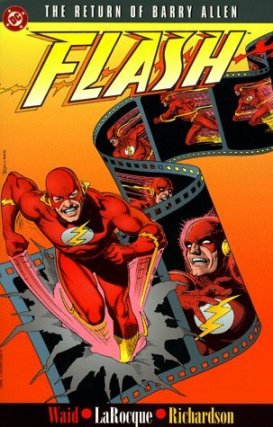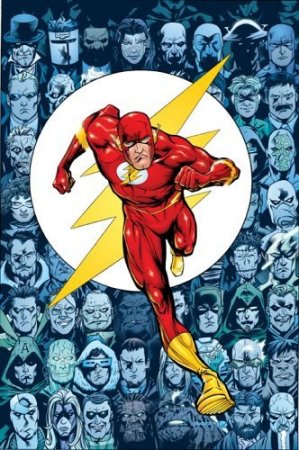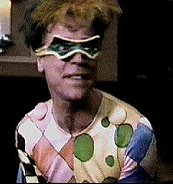| Derek's
Continuity Corner:
"Flash and Substance"
Where to
begin with the rich and odd history of the Flash? As wacky
as it may seem, almost every element that writer Matt Wayne
threw into "Flash and
Substance" has a pretty good analog with the comics.
To begin with
Wally West himself, the episode has melded his personality
with some trappings of his predecessor, Wally's uncle Barry
Allen. This makes sense, as Barry had more focus than Wally
but has also been "dead" in the comics since 1985.
Though it might
seem like jumping on the CSI bandwagon, Barry was
a police scientist (the quaint term) from the get-go in
his first appearance in Showcase #4. That carried
over as well into the live-action show with John Wesley
Shipp, where Wally was never mentioned.
In the comics,
Wally has been a few things, but mostly a professional Flash.
One of the first DC heroes to eschew a secret identity.
Wally ran a delivery service out of college until he won
the lottery. Literally. Now he works as a mechanic in the
Keystone City Police Department auto pool.
That TV reporter
in the episode so heavily crushing on him? Also straight
out of the comics, though not nearly so comical. Linda Park
dated Wally, married him and recently had twins with him.
This would certainly
end the characterization of the desperate guy looking to
pick up on any superheroines hanging out in the Watchtower
- also a reflection of the comics, as the only male member
of the Teen Titans that didn't aggressively play the field
was Aqualad.
The depiction
of Wally as the ultimate Good Samaritan also has echoes
in both Kingdom Come and The Kingdom. There
he has become a remote figure, barely existing in normal
time as he runs around the city constantly preventing crimes.
While it endeared him to the population, it also separated
him from his family.
Last month,
however, Wally possibly ended his career in the DCU by disappearing
into the Speed Force in Infinite Crisis #4. Of course,
his legacy remains as long as a Flash Museum stands.
Dedicated to
the legacy of the Flash, the museum features statues of
his friends and foes, as well as mementos of his strangest
cases. No one has ever adequately explained why Barry Allen
thought it was okay to keep dangerous weapons and devices
on permanent display where anyone could find them.
"Flash and Substance"
nods to the legacy as well, with a quick shot of a boy trying
on a winged helmet. Perhaps in the Timmverse this is a nod
to Hermes, but we can take it as a tacit acknowledgment
of Jay Garrick, the Golden Age Flash. If it is, it's the
first direct reference to the Justice Society, though many
members of the World War II team have been reimagined for
JLU. (An alternate Earth with a team like
the JSA appeared in an episode of Justice League.)
Then there's
the Rogues' Gallery. Unlike most sets of archenemies, the
Flash' foes did actually hang out together. Many writers
had fun with that set-up, including having them gather for
a respectful wake for Barry Allen and even inviting Wally.
For a while, they even struck a truce with Wally, to give
him adequate time to establish himself.
Writer Geoff
Johns also divided the Rogues into two sets: the classic
ones that had fought Barry first, and a newer, more dangerous
grouping that had no real code of honor. In his last arc,
Rogue
War ,
he affirmed the superiority of the old guard, led by Johns'
personal favorite rogue, Captain Cold. ,
he affirmed the superiority of the old guard, led by Johns'
personal favorite rogue, Captain Cold.
"Flash and Substance"
makes Len Snart, Captain Cold, into a henpecked bundle of
nerves, but the comic book Cold actually has a tougher demeanor,
more often than not with a heart as cold as his name. Like
most of the original Rogues' Gallery, he will not cross
the line into killing if he can help it. There have been
notable exceptions, the most recent in the aforementioned
Rogue War.
Also at the
table sat Mirror Master. Since he doesn't have a Scottish
accent, we can assume this is Samuel Scudder, the original
that bedeviled Flash until getting killed in Crisis On
Infinite Earths. Shortly thereafter, the British government
appropriated Scudder's technology and gave it to one of
their agents. That Mirror Master first appeared in early
issues of Animal Man, where he played somewhere in
the middle. Rogue War settled his affiliation.
We've
covered Captain Boomerang in the "Task
Force X" episode, which leaves James Jesse, The Trickster.
Saddled with an unfortunate criminal name and the son of circus
performers, James served as sort of a harmless Joker variation
to the group. (Superman has one, too - the Prankster.) With
a variety of weapons that include shoes that allow him to
walk on air, the Trickster was the second of Flash's enemies
to reform.
Unlike both
television versions, James is not schizophrenic in
the comics. When facing down Neron in Underworld Unleashed,
he realized that when you've tricked the devil, you'd better
serve on the side of the angels. So the Trickster turned
for the FBI, reaching out to his former allies to offer
them redemption by working for the law.
Controversially,
in the aftermath of Identity Crisis it turned out
that James had been mind-altered by Zatanna, though Rogue
War did leave things just vague enough that perhaps
he will continue on the side of good even after his mind
was restored to full capacity.
The first foe
to reform, only glimpsed in "Flash and Substance," was the
Pied Piper, notable because he is one of DC's first openly
gay characters. Despite what Goodson thinks about the Vigilante
and the Shining Knight, Justice League Unlimited
will probably leave that plotline untouched.
|








